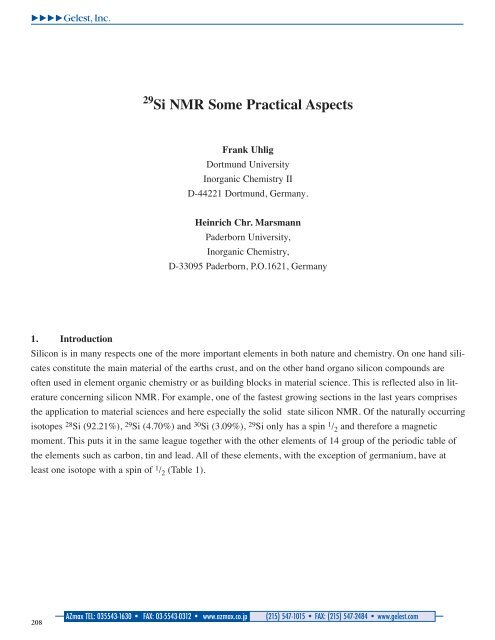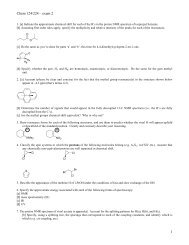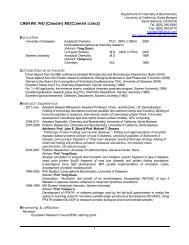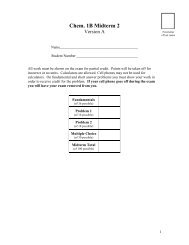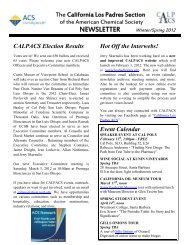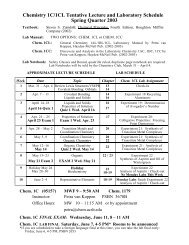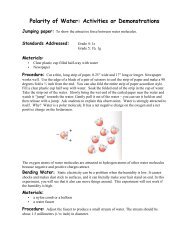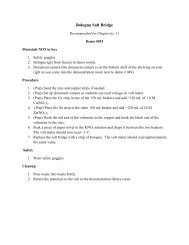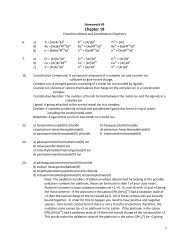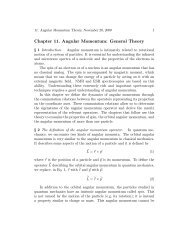29 Si NMR Some Practical Aspects - Pascal-Man
29 Si NMR Some Practical Aspects - Pascal-Man
29 Si NMR Some Practical Aspects - Pascal-Man
You also want an ePaper? Increase the reach of your titles
YUMPU automatically turns print PDFs into web optimized ePapers that Google loves.
Gelest, Inc.<br />
<strong>29</strong> <strong>Si</strong> <strong>NMR</strong> <strong>Some</strong> <strong>Practical</strong> <strong>Aspects</strong><br />
Frank Uhlig<br />
Dortmund University<br />
Inorganic Chemistry II<br />
D-44221 Dortmund, Germany.<br />
Heinrich Chr. Marsmann<br />
Paderborn University,<br />
Inorganic Chemistry,<br />
D-33095 Paderborn, P.O.1621, Germany<br />
1. Introduction<br />
<strong>Si</strong>licon is in many respects one of the more important elements in both nature and chemistry. On one hand silicates<br />
constitute the main material of the earths crust, and on the other hand organo silicon compounds are<br />
often used in element organic chemistry or as building blocks in material science. This is reflected also in literature<br />
concerning silicon <strong>NMR</strong>. For example, one of the fastest growing sections in the last years comprises<br />
the application to material sciences and here especially the solid state silicon <strong>NMR</strong>. Of the naturally occurring<br />
isotopes 28 <strong>Si</strong> (92.21%), <strong>29</strong> <strong>Si</strong> (4.70%) and 30 <strong>Si</strong> (3.09%), <strong>29</strong> <strong>Si</strong> only has a spin 1 / 2 and therefore a magnetic<br />
moment. This puts it in the same league together with the other elements of 14 group of the periodic table of<br />
the elements such as carbon, tin and lead. All of these elements, with the exception of germanium, have at<br />
least one isotope with a spin of 1 / 2 (Table 1).<br />
208<br />
AZmax TEL: 035543-1630 • FAX: 03-5543-0312 • www.azmax.co.jp<br />
(215) 547-1015 • FAX: (215) 547-2484 • www.gelest.com
Gelest, Inc.<br />
Table 1<br />
Group 14 elements, parameter of selected isotopes<br />
Natural Nuclear Magnetic Sensitivity Recept.<br />
Abundance Spin Moment µ d rel.<br />
[%] rel. a) abs. b) to 13 C<br />
13C 1.108 1/ 2 07022 1.59x10 -2 1.76x10 -4 1<br />
<strong>29</strong><strong>Si</strong> 4.7 1/ 2 -0.5548 7.84x10 -3 3.69x10 -4 2.1<br />
73Ge 7.76 9/ c) 2 -0.8768 1.4x10 -3 1.08x10 -4 0.61<br />
119Sn d) 8.58 1/ 2 -1.0409 5.18x10 -3 4.44x10 -3 25.2<br />
207Pb 22.6 1/ 2 0.5843 9.16x10 -3 2.07x10 -3 11.8.<br />
a) at constant field and equal number of nuclei; b) product of relative sensitivity and natural abundance; c) quadrupole<br />
moment, -0.18 x 10 -28 m; d) isotope used in most tin <strong>NMR</strong> experiments, for other relevant nuclei see literature [1] and<br />
cited reviews.<br />
Table 1 shows that <strong>29</strong> <strong>Si</strong> has a higher share in the isotopic mixture but the absolute value of the magnetic<br />
moment is slightly lower than of 13 C. This leads to a lower resonance frequency. A complication arises from<br />
the fact that spin and magnetic moment are antiparallel leading to a negative sign of the gyromagnetic ratio .<br />
Concerning these facts silicon <strong>NMR</strong> had a slow start. After the first report by Lauterbur et al. in 1962 [2] there<br />
have been a few papers per year only. However, since the beginning of the 80´s this has changed dramatically.<br />
Our own data collection of <strong>29</strong> <strong>Si</strong> chemical shifts now contains about 13.000 data sets for more than 6.500 compounds<br />
[3]. A quick search in literature yields around 25.000 compounds with a measured <strong>29</strong> <strong>Si</strong> chemical shift.<br />
Because of these huge amounts of material available in silicon <strong>NMR</strong>, all discussions or reviews must be limited<br />
to special and selected research fields.<br />
2. General aspects<br />
2.1 Using of standards<br />
The only magnetic isotope of silicon <strong>29</strong> <strong>Si</strong> has a natural abundance of 4.7%, a spin of 1 / 2 , a magnetic moment<br />
of -0.9609 and therefore a receptivity of 3.69 x 10 -4 compared to that of 1 H. It can be characterized as a magnetically<br />
diluted isotope of medium sensitivity [4]. <strong>Si</strong>milar to 1 H or 13 C <strong>NMR</strong> the referencing is mostly done<br />
relatively to tetramethylsilane (Me 4 <strong>Si</strong>, TMS) which has the advantages of having a low boiling point, a relatively<br />
short relaxation time and being a chemically relatively inert substance. Therefore, if nescessary, it can<br />
be added directly to the sample. However, its resonance is in a shift range where the resonances of many other<br />
organosilicon compounds occur and so misinterpretations are possible. Two general strategies are usable to<br />
avoid this problem. The first one is the use of secondary standards. <strong>Some</strong> secondary reference standards as<br />
known from literature are collected in Table 2. Unfortuanately, due to their higher reactivity, in contrast to<br />
TMS, they are useful only for a limited number of applications.<br />
AZmax TEL: 035543-1630 • FAX: 03-5543-0312 • www.azmax.co.jp<br />
(215) 547-1015 • FAX: (215) 547-2484 • www.gelest.com<br />
209
Gelest, Inc.<br />
Table 2 Current and historic reference compounds for silicon <strong>NMR</strong><br />
Name Formula Common Chemical shift<br />
Abbreviation relative to TMS<br />
in ppm<br />
Tetramethylsilane Me 4 <strong>Si</strong> TMS 0.0<br />
Tetrakis(trimethylsilyl)methane (Me 3 <strong>Si</strong>) 4 C 3.6<br />
Hexamethyldisiloxane (Me 3 <strong>Si</strong>) 2 O M 2 6.53<br />
Octamethylcyclotetrasiloxane (Me 2 <strong>Si</strong>O) 4 D 4 -19.86<br />
Tetramethoxysilane (MeO) 4 <strong>Si</strong> TMOS -78.54<br />
Tetraethoxysilane (EtO) 4 <strong>Si</strong> TEOS -82.04<br />
Tetrafluorosilane <strong>Si</strong>F 4 -113.5<br />
Tetrakis(trimethylsiloxy)silane (Me 3 <strong>Si</strong>O) 4 <strong>Si</strong> M 4 Q 8.62<br />
-104.08<br />
<strong>Si</strong>licon oil a) (Me 2 <strong>Si</strong>O) x -22.0<br />
a) the use of silicone containing grease for your equipment leads normally also to “impurity” resonances around –22 ppm.<br />
More common, except for precision measurements, is to use no standard compound at all in the sample (tube<br />
interchange technique). In such a case the referencing is done relative to a sample containing TMS in the same<br />
solvent as it was used in the unknown sample.<br />
Negative values of the silicon chemical shift are to low frequency and high field compared to Me 4 <strong>Si</strong>. Special<br />
care must be given by using silicon chemical shift data from earlier reviews and original papers. <strong>Some</strong> of them<br />
employ the magnetic field definition of chemical shifts instead of the currently accepted frequency based one,<br />
resulting in a reversed sign for chemical shift data.<br />
2.2 Problems in <strong>29</strong> <strong>Si</strong> <strong>NMR</strong>, pulse techniques<br />
There are a number of aspects for running into difficulties in measuring silicon <strong>NMR</strong>. The first of it concerns<br />
the fact that silicon containing materials such as glass and ceramics constitute a major part of the construction<br />
material of the probe head and probe tube resulting in a broad background signal at approx. -110 ppm. There<br />
are three general methods to avoid the problem:<br />
210<br />
AZmax TEL: 035543-1630 • FAX: 03-5543-0312 • www.azmax.co.jp<br />
(215) 547-1015 • FAX: (215) 547-2484 • www.gelest.com
Gelest, Inc.<br />
1. In the case of narrow signals, the smallest sweep width possible should<br />
be used.<br />
2. Population transfer pulse programs such as DEPT otr INEPT can be used if the silicon atoms are coupling<br />
with protons or fluorine for example.<br />
3. If broad lines are measured, you might be able to subtract it from a blanc spectrum obtained under otherwise<br />
identical conditions.<br />
One other characteristic feature regarding spectra of organosilicon compounds is usually observed under broad<br />
band decoupling of protons. Resonances of silicon atoms containing organic substituents split into many lines<br />
by spin-spin couplings with the protons. This is mostly prevented by decoupling experiments. However, the<br />
Nuclear Overhauser Effect (NOE) can then lead to zero signals, if the ( <strong>29</strong> <strong>Si</strong>, 1 H) dipol-dipol contribution T DD 1<br />
to the other longitudinal relaxation paths of the silicon is close to 1.52. The relaxation times depend on the<br />
correlation times of a molecule, therefore, the signal intensity of a <strong>29</strong> <strong>Si</strong> spectrum with NOE varies with the<br />
temperature. Again there are three ways to turn around the situation:<br />
1. Adding of shiftless relaxation reagents, for example the well-known Cr(acac) 3 in a concentration of<br />
~10 -2 mol/l).<br />
2. Using of inverse gated decoupling. Here proton decoupling is only active during aquisition with long<br />
waiting times (3 to 5 times the relaxation time T 1 ) between scans. The advantage of not polluting the<br />
sample is offset by ineffective use of spectrometer time which can be alleviated somewhat by using<br />
shorter pulses (40°) and shorter recovery times (20s).<br />
3. Use of population transfer pulse programs such as INEPT or DEPT [5].<br />
A third disadvantage in measuring silicon <strong>NMR</strong> spectra is related especially with “pure’’ inorganic compounds<br />
containing only <strong>29</strong> <strong>Si</strong> as an, for <strong>NMR</strong> experiments, useful nucleus. In such cases single pulse experiments are<br />
applicable only. Due to the slow relaxation in such compounds, a 30° pulse is used with repetition rates of<br />
about 20s.<br />
Solid state silicon-<strong>29</strong> <strong>NMR</strong> differs from these solutions inasmuch as the spatial interactions are not averaged<br />
out by particle motion, resulting in broad lines and all the problems are related to that fact. Literature about<br />
<strong>29</strong><strong>Si</strong> solid state <strong>NMR</strong> is given in reference [6].<br />
3. Chemical shifts<br />
The majority of <strong>29</strong> <strong>Si</strong> <strong>NMR</strong> shifts are found in a range between +50 and -200 ppm. However, as far as we know<br />
the current upfield and downfield “world records’’ are formed by divalent silicon compounds. The largest<br />
upfield shift is measured for the decamethylsilicocene (1) with -392 ppm [7]. The highest downfield shift is<br />
given for compound 2 with 567 ppm [8].<br />
AZmax TEL: 035543-1630 • FAX: 03-5543-0312 • www.azmax.co.jp<br />
(215) 547-1015 • FAX: (215) 547-2484 • www.gelest.com<br />
211
Gelest, Inc.<br />
1 2<br />
-392 ppm +567 ppm<br />
The border lines for silicon(IV) compounds are given by the tetraiodosilane (3) with a chemical shift of –350<br />
ppm [9] and the central silicon atom of the dihypersilylplumbandiyl (4) with +197 ppm [10].<br />
<strong>Si</strong>I 4<br />
[(Me 3 <strong>Si</strong>) 3 <strong>Si</strong>] 2 Pb<br />
3 4<br />
-350 ppm +197 ppm<br />
The name hypersilyl is used mainly as abbreviation for the tris(trimethylsilyl)silyl substituent, as supersilyl is<br />
used as abbreviation for the tritbutylsilyl group.<br />
Derivatives containing the trimethylsilyl group, (CH 3 ) 3 <strong>Si</strong>-, abbreviated also as TMS, form the largest group of<br />
compounds with a known <strong>29</strong> <strong>Si</strong> <strong>NMR</strong> shift. One reason to introduce one of these groups into a molecule is to<br />
obtain a certain substitution pattern in organic chemistry [11]. Another reason is for example the fact to make<br />
substances now containing Me 3 O<strong>Si</strong>- or Me 3 <strong>Si</strong>N-groups instead of labile protons in HO- or HN-groups easier<br />
to handle. For instance the volatility or the solubility in organic solvents is much better for the derivatized<br />
compound. The TMS group is also useful for the characterization of such compounds by <strong>NMR</strong> methods [20].<br />
The shift of TMS groups ranges from –34.4 ppm for Me 3 <strong>Si</strong> - K + [21] up to 83.6 ppm for [Me 3 <strong>Si</strong>] + [B(C 6 F 5 ) 4 ] -<br />
[22]. An overview about typical shift ranges of trimethylsilyl substituted compounds is given in Scheme 1.<br />
212<br />
AZmax TEL: 035543-1630 • FAX: 03-5543-0312 • www.azmax.co.jp<br />
(215) 547-1015 • FAX: (215) 547-2484 • www.gelest.com
Gelest, Inc.<br />
Me 3 <strong>Si</strong>-transition metal<br />
Me 3 <strong>Si</strong>-X<br />
Me 3 <strong>Si</strong>-P/As/Sb<br />
Me 3 <strong>Si</strong>-N<br />
Me 3 <strong>Si</strong>-S/Se<br />
Me 3 <strong>Si</strong>-O<br />
Me 3 <strong>Si</strong>-<strong>Si</strong>/Ge/Sn<br />
Me 3 <strong>Si</strong>-C<br />
Scheme 1: Typical shift ranges of trimethylsubstituted derivatives.<br />
Selected borderline case examples for each class of compounds are given.<br />
One of the first uses of silicon-<strong>29</strong> <strong>NMR</strong> was its application to siloxane polymers. Although it is still possible<br />
sometimes to recognize and isolate individual molecules, the main view is to dissect the molecules into building<br />
units (see Scheme 2).<br />
R R R R R R O R<br />
| | | | | | | |<br />
R - <strong>Si</strong> - O - <strong>Si</strong> - O - <strong>Si</strong> - O - <strong>Si</strong> - O - <strong>Si</strong> - O - <strong>Si</strong> - O - <strong>Si</strong> - O - <strong>Si</strong> - O-<br />
| | | | | | | |<br />
R R R R O R O R<br />
| |<br />
End- (M) Middle- (D) Trifunctional (T) Tetrafunctional (Q)<br />
Groups<br />
Branching Groups<br />
M D T (Q)<br />
R = Me 3 7 – 9 ppm Me 2 -17 to –22 Me -55 to –65 -105 to -115<br />
Me 2 Cl ~5 Cl 2 ~ -73 HO ~ -100<br />
MeCl 2 ~ -20 Me/H ~ -35 H ~ -85<br />
Cl 3 ~ -48 Me/OH ~ -55 Ph ~ -78<br />
Ph 3 ~ -10 Ph/OH ~ -70<br />
Ph 2 -42±3<br />
Scheme 2: Building units and shift range of selected siloxanes in ppm.<br />
AZmax TEL: 035543-1630 • FAX: 03-5543-0312 • www.azmax.co.jp<br />
(215) 547-1015 • FAX: (215) 547-2484 • www.gelest.com<br />
213
Gelest, Inc.<br />
The main difference between the building units is the number of oxygen atoms connected to a silicon atom.<br />
Except for the M group, the exchange of a R substituent for oxygen leads to an upfield shift. The chemical<br />
shifts of the building units are sensitive to neighbor effects in the chain structure revealing the microstructure<br />
of polymers. The chemical shifts of all building groups are modified by ring strain if cyclic siloxanes are<br />
investigated by <strong>29</strong> <strong>Si</strong> <strong>NMR</strong>.<br />
<strong>Si</strong>lazenes possess structural similarities to siloxanes and can be rationalized by the analogeous principles,<br />
however the range of chemical shifts is smaller. The total region extends from -62 to +18 ppm [12]. The same<br />
is true for carbosilanes. Resonances for silicon atoms bonded to 4 carbon atoms are found between -4 and +20<br />
ppm [12]. A new report concerning silthianes has appeared recently [13].<br />
Oligomeric and polymeric silanes are discussed in detail in the literature [14] and some of the appropriate references<br />
should looked up there. The ranges of chemical shifts of building components for oligosilanes are collected<br />
in Table 3. The skeleton of these compounds is similar to those of alkanes. A number of studies on substituted<br />
di- and trisilanes are also discussed in the article mentioned above.<br />
Table 3: Selected chemical shifts of polysilane units in ppm<br />
R Endgroup Middle group Trifunctional Tetrafunctional<br />
group<br />
group<br />
R 3 <strong>Si</strong>-<strong>Si</strong> R 2 <strong>Si</strong>(<strong>Si</strong>) 2 R<strong>Si</strong>(<strong>Si</strong>) 3 <strong>Si</strong>(<strong>Si</strong>) 4<br />
Me -4 ± 5 -28 to –50 -65 to -95 -109 to –165 b)<br />
Ph -19 ± 3 -40 to –50 -75 to -85<br />
Ph/H -30 -65 ± 5<br />
Me/H -35 ± 2 -70 ± 5<br />
Me 2 /Cl a) 28 ± 2<br />
tBu 20 to 30<br />
a) for BrMe 2 <strong>Si</strong>: 21 ppm, IMe 2 <strong>Si</strong>: 2 ppm; b) exception <strong>Si</strong>(<strong>Si</strong>Cl 3 ) 3 (<strong>Si</strong>Cl 2 <strong>Si</strong>Cl 3 ): -79.5 ppm<br />
The chemistry of silicon containing double bonds was a rapid growing field during the last 15-20 years. For silicon-silicon<br />
double bonds, <strong>29</strong> <strong>Si</strong> <strong>NMR</strong> chemical shifts are reported from ~50 ppm up to ~160 ppm (examples:<br />
49.4 ppm [Mes((Me 3 <strong>Si</strong>) 2 N)<strong>Si</strong>] 2 [25]; 156.2 ppm ( t BuMe 2 <strong>Si</strong>) 2 <strong>Si</strong>=<strong>Si</strong>(<strong>Si</strong> i Pr 2 Me) 2 [26]) and for silicon carbon<br />
double bonds a range of ~130 ppm is given (13.1 ppm [2,4,6- i Pr 3 C 6 H 2 ] 2 <strong>Si</strong>=C=C(Ph) t Bu [27]; 144.2 ppm<br />
Me 2 <strong>Si</strong>=C(<strong>Si</strong>Me 3 )<strong>Si</strong> t Bu 2 Me [28]). The chemical shifts of silicon having a double bond to a transition metal<br />
214<br />
AZmax TEL: 035543-1630 • FAX: 03-5543-0312 • www.azmax.co.jp<br />
(215) 547-1015 • FAX: (215) 547-2484 • www.gelest.com
Gelest, Inc.<br />
strongly depends on the substituents on the transition metal and the metal itself. Chemical shifts are observed<br />
in a range of ~ -10 ppm (for example: –9.4 ppm for [( t BuO) 2 <strong>Si</strong>=Fe(CO) 4 ]*THF [23]) and nearly 145 ppm<br />
(for example: 141.9 ppm for [(Me 2 N-C 10 H 6 )(H)<strong>Si</strong>=Mn(CO) 2 (MeCp)] [24]).<br />
The data of a number of other transition metal complexes are collected in some reviews [12, 14, 15, 16]. Due<br />
to the large variety for the bonding situations of the silicon a great spread of chemical shifts ranging from 289<br />
ppm [17] up to -150 ppm [18] is observed.<br />
For other compounds, especially for higher coordinated silicon derivatives, general collections of silicon<br />
chemical shifts might be consulted [3, 12, 19].<br />
4. Coupling constants<br />
All magnetic nuclei in a molecule interact and the splitting caused by this gives rise to typical coupling patterns.<br />
Two cases can be distinguished:<br />
1. Coupling with 100% isotopes such as 1 H, 19 F or 31 P gives the well-known splitting patterns in the <strong>29</strong> <strong>Si</strong><br />
spectra. Couplings with quadrupolar nuclei such as the isotopes of chlorine are usually not observed.<br />
2. Coupling with other rare spins such as <strong>29</strong> <strong>Si</strong>, 119/117 Sn or 13 C leads to smaller satellite lines left and right to<br />
the main line according to their abundance in the usual <strong>29</strong> <strong>Si</strong> spectra.<br />
The ranges of some silicon-element coupling constants are found in Table 4. The sign of coupling constants<br />
over one bond is mostly negative because of the negative magnetogyric ratio of the <strong>29</strong> <strong>Si</strong>. Exceptions are found<br />
if the silicon is connected to an element with tightly bonded s-electrons e.g. 19 F or 31 P.<br />
Table 4<br />
Ranges of selected silicon element coupling constants (without sign)<br />
<strong>Si</strong>-X coupling (X) 1J(<strong>Si</strong>-X) in Hz 2J(<strong>Si</strong>-X) in Hz 3J(<strong>Si</strong>-X) in Hz<br />
(largest – smallest) (largest – smallest) (largest – smallest)<br />
1H 420 - 75 10 – 3 (<strong>Si</strong>CH 3 ) 8 – 1<br />
13 – 1 (<strong>Si</strong>XH)<br />
19F 488 - 108 91 – 17 16 – 2<br />
31P 256 - 16 44 -
Gelest, Inc.<br />
5 Reviews, Databases of <strong>29</strong> <strong>Si</strong> <strong>NMR</strong> Data<br />
A large number of review articles deal with selected and special fields of <strong>29</strong> <strong>Si</strong> <strong>NMR</strong> but, only a limited number<br />
of general collections of <strong>29</strong> <strong>Si</strong> <strong>NMR</strong> chemical shifts or coupling constants exist. An electronic version of a<br />
<strong>29</strong><strong>Si</strong> <strong>NMR</strong> database is available from the authors of this article [3]. Further information is available via the<br />
world wide web (http:\\www.silicium-nmr.de) or directly from the authors. A printed general review and an<br />
(incomplete) <strong>29</strong> <strong>Si</strong> <strong>NMR</strong> data collection will be available within the Landolt-Börnstein series (Springer publishing<br />
house) hopefully in 2003/2004.<br />
Table 5 Selected <strong>29</strong> <strong>Si</strong> <strong>NMR</strong> chemical shifts (see reference [5])<br />
Formula Sum formula Chemical shift [ppm] a) Gelest product code<br />
Et 4 <strong>Si</strong> C 8 H 20 <strong>Si</strong> 7.1 SIT7115.0<br />
Me 4 <strong>Si</strong> C 4 H 12 <strong>Si</strong> 0 SIT7555.0<br />
Me 3 <strong>Si</strong>Cl C 3 H 9 Cl<strong>Si</strong> 30 SIT8510.0/.1<br />
Me 3 <strong>Si</strong>Br C 3 H 9 Br<strong>Si</strong> 26 SIT8430.0<br />
Me 3 <strong>Si</strong>I C 3 H 9 I<strong>Si</strong> 8.7 SIT8564.0<br />
Me 3 <strong>Si</strong>F C 3 H 9 F<strong>Si</strong> 31.0 SIT8525.0<br />
Me 3 <strong>Si</strong>OSO 2 CF 3 C 4 H 9 F 3 O 4 S<strong>Si</strong> 44 SIT8620.0<br />
Me 3 <strong>Si</strong>C ≡ CH C 5 H 10 <strong>Si</strong> -17.5 SIE4904.0<br />
Me 3 <strong>Si</strong>C ≡ C<strong>Si</strong>Me 3 C 8 H 18 <strong>Si</strong> 2 -19.4 SIB1850.0<br />
Me 2 <strong>Si</strong>Cl 2 C 2 H 6 Cl 2 <strong>Si</strong> 32 SID4120.0/.1<br />
Me<strong>Si</strong>Cl 3 CH 3 Cl 3 <strong>Si</strong> 12 SIM6520.0/.1<br />
Ph 4 <strong>Si</strong> C 24 H 20 <strong>Si</strong> -14 SIT7755.0<br />
Ph 3 <strong>Si</strong>Cl C 18 H 15 Cl<strong>Si</strong> 1.5 SIT8645.0<br />
Ph 3 <strong>Si</strong>F C 18 H 15 F<strong>Si</strong> 4.35 SIT8655.0<br />
Ph 2 <strong>Si</strong>Cl 2 C 12 H 10 Cl 2 <strong>Si</strong> 6.2 SID4510.0/.1<br />
Ph 2 <strong>Si</strong>F 2 C 12 H 10 F 2 <strong>Si</strong> -30 SID4530.0<br />
Ph<strong>Si</strong>Cl 3 C 6 H 6 Cl 3 <strong>Si</strong> -0.8 SIP6810.0<br />
<strong>Si</strong>Cl 4 Cl 4 <strong>Si</strong> -18 SIT7085.0<br />
<strong>Si</strong>Br 4 Br 4 <strong>Si</strong> -92 SIT7050.0<br />
<strong>Si</strong>I 4 I 4 <strong>Si</strong> -350 SIT7123.0<br />
<strong>Si</strong>F 4 F 4 <strong>Si</strong> -112 SIT7120.0<br />
216<br />
AZmax TEL: 035543-1630 • FAX: 03-5543-0312 • www.azmax.co.jp<br />
(215) 547-1015 • FAX: (215) 547-2484 • www.gelest.com
Gelest, Inc.<br />
Formula Sum formula Chemical shift [ppm] a) Gelest product code<br />
H 2 <strong>Si</strong>Cl 2 H 2 Cl 2 <strong>Si</strong> -11.3 SID3368.0/.2<br />
H<strong>Si</strong>Cl 3 HCl 3 <strong>Si</strong> -9.4 SIT8155.0<br />
(CH 2 =CH-CH 2 ) 4 <strong>Si</strong> C 12 H 20 <strong>Si</strong> -2 SIT7020.0<br />
CH 2 =CH-CH 2 <strong>Si</strong>Me 2 Cl C 5 H 11 Cl<strong>Si</strong> 27.2 SIA0460.0<br />
CH 2 =CH-CH 2 <strong>Si</strong>MeCl 2 C 4 H 8 Cl 2 <strong>Si</strong> 26.8 SIA0470.0<br />
CH 2 =CH-CH 2 <strong>Si</strong>Cl 3 C 3 H 5 Cl 3 <strong>Si</strong> 8 SIA0520.0<br />
CH 2 =CH<strong>Si</strong>Cl 3 C 2 H 3 Cl 3 <strong>Si</strong> -3 SIV9110.0<br />
PhCH 2 <strong>Si</strong>Cl 3 C 7 H 7 Cl 3 <strong>Si</strong> 7.2 SIB0970.0<br />
Me<strong>Si</strong>(CH 2 Cl)Cl 2 C 2 H 5 Cl 3 <strong>Si</strong> 21.6 SIC2<strong>29</strong>0.0<br />
Me 2 <strong>Si</strong>(CH 2 Cl) 2 C 4 H 10 Cl 2 <strong>Si</strong> -3.5 SIB1051.0<br />
C 8 H 19 Cl<strong>Si</strong> 35.8 SIT7906.0<br />
tBuMe 2 <strong>Si</strong>Cl C 6 H 15 Cl<strong>Si</strong> 33 SIB1935.0<br />
PhMe<strong>Si</strong>(H)Cl C 7 H 9 Cl<strong>Si</strong> 1.3 SIP6738.0<br />
Me 2 (H)<strong>Si</strong>Cl C 2 H 7 Cl<strong>Si</strong> -11.1 SID4070.0<br />
Ph<strong>Si</strong>H 3 C 6 H 8 <strong>Si</strong> -60 SIP6750.0<br />
Ph 2 <strong>Si</strong>H 2 C 12 H 12 <strong>Si</strong> -34 SID4559.0<br />
Ph 3 <strong>Si</strong>H C 18 H 16 <strong>Si</strong> -17 to -22 SIT8665.0<br />
Me 2 <strong>Si</strong>H 2 C 2 H 8 <strong>Si</strong> -37 to -48 SIM6515.0<br />
Me<strong>Si</strong>H 3 CH 6 <strong>Si</strong> -65 SID4230.0<br />
Me 3 <strong>Si</strong>H C 3 H 10 <strong>Si</strong> -17 SIT8570.0<br />
Et 3 <strong>Si</strong>H C 6 H 16 <strong>Si</strong> 0.2 SIT8330.0<br />
(EtO) 3 <strong>Si</strong>H C 6 H 16 O 3 <strong>Si</strong> -60 to -65 SIT8185.0<br />
(EtO) 4 <strong>Si</strong>; TEOS C 8 H 20 O 4 <strong>Si</strong> -82 SIT7110.0/.1<br />
(PhO) 4 <strong>Si</strong> C 24 H 20 O 4 <strong>Si</strong> -101.1 -<br />
(MeO) 4 <strong>Si</strong>, TMOS C 4 H 12 O 4 <strong>Si</strong> -79.5 SIT7510.0/.2<br />
(MeO) 3 <strong>Si</strong>Cl C 3 H 9 ClO 3 <strong>Si</strong> -66.6 -<br />
(MeO) 2 <strong>Si</strong>Cl 2 C 2 H 6 Cl 2 O 2 <strong>Si</strong> -52.6 -<br />
AZmax TEL: 035543-1630 • FAX: 03-5543-0312 • www.azmax.co.jp<br />
(215) 547-1015 • FAX: (215) 547-2484 • www.gelest.com<br />
217
Gelest, Inc.<br />
Formula Sum formula Chemical shift [ppm] a) Gelest product code<br />
MeO<strong>Si</strong>Cl 3 CH 3 Cl 3 O<strong>Si</strong> -36.1 -<br />
EtO<strong>Si</strong>Cl 3 C 2 H 5 Cl 3 O<strong>Si</strong> -38.3 -<br />
Ph 2 <strong>Si</strong>(OH) 2 C 12 H 12 O 2 <strong>Si</strong> -33.9 SID4560.0<br />
Ph 3 <strong>Si</strong>OH C 18 H 16 O<strong>Si</strong> -12 to -24 SIT8695.0<br />
Et 3 <strong>Si</strong>OH C 6 H 16 O<strong>Si</strong> 19.3 SIT8332.0<br />
Me 3 <strong>Si</strong>ONa C 3 H 9 NaO<strong>Si</strong> -4 to -11 SIS6988.0<br />
Me 3 <strong>Si</strong>-O-<strong>Si</strong>Me 3 C 6 H 18 O<strong>Si</strong> 6 SIH6115.0<br />
Me 3 <strong>Si</strong>-O-O-<strong>Si</strong>Me 3 C 6 H 18 O 2 <strong>Si</strong> 27.3 SIB1868.0<br />
Me 3 <strong>Si</strong>-S-<strong>Si</strong>Me 3 C 6 H 18 S<strong>Si</strong> 13 SIH6116.0<br />
Me 3 <strong>Si</strong>-O-Me 2 <strong>Si</strong>-O-<strong>Si</strong>Me 3 , MDM C 8 H 24 O 2 <strong>Si</strong> 3 6.5 (Me 3 <strong>Si</strong>) SIO6703.0<br />
-22(Me 2 <strong>Si</strong>)<br />
Me 3 <strong>Si</strong>O(Me 2 <strong>Si</strong>O) 3 <strong>Si</strong>Me 3 , MD 3 M C 8 H 24 O 2 <strong>Si</strong> 3 6.8 (Me 3 <strong>Si</strong>) SID4626.0<br />
-21.9<br />
(2xMe 2 <strong>Si</strong>)<br />
-22.6 (Me 2 <strong>Si</strong>)<br />
(Me 3 <strong>Si</strong>-O) 4 <strong>Si</strong>, M 4 Q C 12 H 36 O 4 <strong>Si</strong> 5 8 (Me 3 <strong>Si</strong>) SIT7<strong>29</strong>8.0<br />
-105 (<strong>Si</strong>)<br />
(Me 3 <strong>Si</strong>-O) 3 <strong>Si</strong>Me, M 3 T C 10 H 30 O 3 <strong>Si</strong> 4 7 (Me 3 <strong>Si</strong>) SIM6592.0<br />
-65 (<strong>Si</strong>)<br />
(-Me 2 <strong>Si</strong>-O-) 3 , D 3 C 6 H 18 O 3 <strong>Si</strong> 3 -9 SIH6105.0/.1<br />
(-PhMe<strong>Si</strong>-O-) 3 C 21 H 24 O 3 <strong>Si</strong> 3 -20.8 SIT8705.0<br />
(-Ph 2 <strong>Si</strong>-O-) 3 C 36 H 30 O 3 <strong>Si</strong> 3 -33.8 -<br />
(-Me 2 <strong>Si</strong>-O-) 4 , D 4 C 8 H 24 O 4 <strong>Si</strong> 4 -20 SIO6700.0<br />
(-Me(H)<strong>Si</strong>-O-) 4 , D´4 C 4 H 16 O 4 <strong>Si</strong> 4 -32.5 SIT7530.0<br />
(-Ph 2 <strong>Si</strong>-O-) 4 C 48 H 40 O 4 <strong>Si</strong> 4 -46 SIO6705.0<br />
(-Me 2 <strong>Si</strong>-O-) x , silicon oil Molecular weight -22 DMS-TXX<br />
160-423,000<br />
218<br />
AZmax TEL: 035543-1630 • FAX: 03-5543-0312 • www.azmax.co.jp<br />
(215) 547-1015 • FAX: (215) 547-2484 • www.gelest.com
Gelest, Inc.<br />
Formula Sum formula Chemical shift [ppm] a) Gelest product code<br />
T8-silsesquioxane<br />
R=vinyl C 16 H 24 O 12 <strong>Si</strong> 8 -79.4 SIO6706.0<br />
Me 2 (H)<strong>Si</strong> C 16 H 56 O 20 <strong>Si</strong> 16 0.5 Me 2 <strong>Si</strong>(H) SIO6696.5<br />
H H 8 O 12 <strong>Si</strong> 8 -84.5 SIH6168.0<br />
Me 2 (H)<strong>Si</strong>-O-<strong>Si</strong>(H)Me 2 C 4 H 14 O<strong>Si</strong> 2 -5 SIT7546.0<br />
Me 2 (Cl)<strong>Si</strong>-O-<strong>Si</strong>(Cl)Me 2 C 4 H 12 Cl 2 O<strong>Si</strong> 2 9.6 SID3372.0<br />
Me 2 (Cl)<strong>Si</strong>-O-Me 2 <strong>Si</strong>-<strong>Si</strong>(Cl)Me 2 C 6 H 18 Cl 2 O 2 <strong>Si</strong> 3 -18.3 (Me 3 <strong>Si</strong>) SID3360.0<br />
2.3 (<strong>Si</strong>Cl)<br />
Cl 3 <strong>Si</strong>-O-<strong>Si</strong>Cl 3 Cl 6 O<strong>Si</strong> 2 -46 SIH5910.0<br />
(MeO) 3 <strong>Si</strong>-<strong>Si</strong>(OMe) 3 C 6 H 18 O 6 <strong>Si</strong> 2 -52.5 SIH6101.0<br />
R = vinyl C 8 H 15 NO 3 <strong>Si</strong> -80 SIV9097.0<br />
Me C 7 H 15 NO 3 <strong>Si</strong> -63 SIM6518.0<br />
(Me 2 N) 4 <strong>Si</strong> C 8 H 24 N 4 <strong>Si</strong> -28.1 SIT7276.0<br />
(Me 2 N) 3 <strong>Si</strong>Me C 7 H 21 N 3 <strong>Si</strong> -17 SIT8712.0<br />
(Et 2 N) 2 <strong>Si</strong>Me 2 C 6 H 18 N 2 <strong>Si</strong> -1.8 SIB1095.0<br />
Me 2 N-<strong>Si</strong>Me 3 C 5 H 15 N<strong>Si</strong> -6 SID3605.0<br />
(Me 3 <strong>Si</strong>) 2 NH; HMDZ, HMDS C 6 H 19 N<strong>Si</strong> 2 2.2 SIH6110.0<br />
AZmax TEL: 035543-1630 • FAX: 03-5543-0312 • www.azmax.co.jp<br />
(215) 547-1015 • FAX: (215) 547-2484 • www.gelest.com<br />
219
Gelest, Inc.<br />
Formula Sum formula Chemical shift [ppm] a) Gelest product code<br />
(Me 3 <strong>Si</strong>) 3 N C 9 H 27 N<strong>Si</strong> 3 2.4 SIN6595.0<br />
(-Me 2 <strong>Si</strong>-NH-) 3 C 6 H 21 N 3 <strong>Si</strong> 3 -4 SIT6102.0<br />
(-Me 2 <strong>Si</strong>-NH-) 4 C 8 H 28 N 4 <strong>Si</strong> 4 -8.2 SIO6698.0<br />
(Me 3 <strong>Si</strong>-O) 3 B C 9 H 27 BO 3 <strong>Si</strong> 3 12.3 SIT8718.0<br />
(Me 3 <strong>Si</strong>-O) 3 P=O C 9 H 27 O 4 P<strong>Si</strong> 3 20 SIT8723.0<br />
(Me 3 <strong>Si</strong>) 3 P C 9 H 27 P<strong>Si</strong> 3 0.2 -<br />
Me 3 <strong>Si</strong>-<strong>Si</strong>Me 3 C 6 H 18 <strong>Si</strong> 2 -19.5 SIH6109.0<br />
PhMe 2 <strong>Si</strong>-<strong>Si</strong>Me 2 Ph C 16 H 22 <strong>Si</strong> 2 -21.8 SID4584.0<br />
Ph 2 Me<strong>Si</strong>-<strong>Si</strong>MePh 2 C 26 H 26 <strong>Si</strong> 2 -22 SID4238.0<br />
Ph 3 <strong>Si</strong>-<strong>Si</strong>Ph 3 C 36 H 30 <strong>Si</strong> 2 -26.5 SIH6155.0<br />
ClMe 2 <strong>Si</strong>-<strong>Si</strong>Me 2 Cl C 4 H 12 Cl 2 <strong>Si</strong> 2 17 SID3370.0<br />
Cl 2 Me<strong>Si</strong>-<strong>Si</strong>Me 2 Cl C 3 H 9 Cl 3 <strong>Si</strong> 2 15.4 (<strong>Si</strong>Cl) -<br />
25 (<strong>Si</strong>Cl 2 )<br />
Cl 2 Me<strong>Si</strong>-<strong>Si</strong>MeCl 2 C 2 H 6 Cl 4 <strong>Si</strong> 2 18 -<br />
Cl 3 <strong>Si</strong>-<strong>Si</strong>Cl 3 Cl 6 <strong>Si</strong> 2 -6.2 SIH5905.0<br />
(-Me 2 <strong>Si</strong>-) 6 C 12 H 36 <strong>Si</strong> 6 -41.6 SID4623.0<br />
(Me 3 <strong>Si</strong>) 3 <strong>Si</strong>Me C 10 H 30 <strong>Si</strong> 4 -12.5 (Me 3 <strong>Si</strong>) -<br />
-87.9 (<strong>Si</strong>Me)<br />
(Me 3 <strong>Si</strong>) 4 <strong>Si</strong> C 12 H 36 <strong>Si</strong> 5 -9.8 (Me 3 <strong>Si</strong>) SIT7308.0<br />
-135.5 (<strong>Si</strong>)<br />
n-Bu 3 Sn-<strong>Si</strong>Me 3 C 15 H 36 <strong>Si</strong>Sn -8 SNT8585<br />
a) chemical shifts without decimal point are due to different values with deviations of ±2 ppm.<br />
220<br />
AZmax TEL: 035543-1630 • FAX: 03-5543-0312 • www.azmax.co.jp<br />
(215) 547-1015 • FAX: (215) 547-2484 • www.gelest.com
Gelest, Inc.<br />
REFERENCES<br />
1. C. Brevard, P. Granger; “Handbook of High Resolution Multinuclear <strong>NMR</strong>”<br />
John Wiley & Sons, Chichester, 1981.<br />
2. P. C. Lauterbur; Determination Org. Struct. Phys.Methods 2 (1962) 511.<br />
3. U. Hermann, H. Marsmann, F. Uhlig; <strong>29</strong> <strong>Si</strong> <strong>NMR</strong> Database System (PC based,<br />
see also http:\\www.silicium-nmr.de).<br />
4. R. K. Harris, B. E. <strong>Man</strong>n; “<strong>NMR</strong> and the the Periodic Table”, Academic Press, New York, 1978.<br />
5. T. A. Blinka, B. J. Helmer, R. West; Adv. Organomet. Chem. 23 (1984) 193.<br />
6. a) G. Engelhardt, D. Michel; “High resolution Solid-State <strong>NMR</strong> of <strong>Si</strong>licates and<br />
Zoelites”, Wiley, Chichester, 1987;<br />
b) F. Babonneau, V. Gualandris, J. Maquet, D. Massiot, M. T. Janicke, B. F. Chmelka; J. Sol-Gel Science<br />
and Technology 19 (2000) 113;<br />
c) A. Matijasic, A. R. Lewis, C. Marichal, L. Delmotte, J.-M. Chezeau, J. Patarin; Phys. Chemistry Chemical<br />
Physics 2 (2000) 2807; C. A. Colin, A. R. Lewis, J.-M. Chezeau; Can. J. Chem. 77 (1999) 1984.<br />
7. P. Jutzi, U. Holtmann, D. Kanne, C. Krüger, R. Blam, R. Gleiter, I. Hyala-Kryspin; Chem. Ber. 122<br />
(1989) 16<strong>29</strong>.<br />
8. M. Kira, S. Ishida, T. Iwamoto, C. Kabuto; J. Am. Chem. Soc. 121 (1999) 9722.<br />
9. a) H. C. Marsmann, H. G. Horn; Chem.-Ztg. 96 (1972) 456;<br />
b) U. Niemann, H. C. Marsmann; Z. Naturforsch. 30b (1975) 202.<br />
10. K. W. Klinkhammer, W. Schwarz; Angew. Chem. 107 (1995) 1448.<br />
11. E. Colvin; “<strong>Si</strong>licon in organic Synthesis”, Butterworths, London, 1981.<br />
12. H. Marsmann; in “<strong>NMR</strong> Basic Principles and Progress”, Vol 17, 65-235, Springer Verlag, Heidelberg,<br />
1981.<br />
13. a) H.-G. Horn; J. Prakt. Chem. 334 (1992) 201;<br />
b) G. Roewer, U. Herzog; Main Group Metal Chemistry 22 (1999) 579;<br />
c) U. Herzog, U. Böhme, G. Rheinwald; J. Organomet. Chem. 612 (2000) 133.<br />
14. E. A. Williams; in “The Chemistry of Organic <strong>Si</strong>licon Compounds”, Ed. S. Patai, Z. Rappoport, Vol. 1.<br />
511, J. Wiley&Sons.<br />
15. P. D. Likiss; Chem. Soc. Rev. (1992) 271.<br />
16. R. Krentz, R. K. Pommeroy; Inorg. Chem. 24 (1985) <strong>29</strong>76.<br />
17. J. Arnold, T. D. Tilley, A. L. Rheingold, S. J. Geib; Inorg. Chem. 26 (1987) 2106.<br />
18. Y. Kawano, H. Tobita, H. Ogino; J. Organomet. Chem. 428 (1992) 125.<br />
19. E. A. Williams, J. D. Cargioli; in “Annual Reports in <strong>NMR</strong> Spectroscopy”, Vol. 9, 221, Academic Press,<br />
New York, 1979.<br />
20. J. Schraml; Progr. Nucl. Magn. Reson. Spectrosc. 22 (1990) 289.<br />
21. G. A. Olah, R. J. Hunadi; J. Am. Chem. Soc. 102 (1990) 6989.<br />
22. P. D. Lickiss; in “The Chemistry of Organic <strong>Si</strong>licon Compounds”, Ed. S. Patai, Z. Rappoport, Vol. 2, J.<br />
Wiley&Sons 1998.<br />
23. P. D. Lickiss; Chem. Soc. Rev. 1992.<br />
24. R. J. P. Corriu, B. P. S. Chauhan, G. F. Lanneau; Organometallics 14 (1995) 1646.<br />
25. R. West ; Angew. Chem. 99 (1987) 1231.<br />
26. M. Kira, S. Ohya, T. Iwamoto, M. Ichinhe, C. Kabuto; Organometallics 19 (2000) 1817.<br />
27. M. Trommer, G. E. Miracle, B. E. Eichler, D. R. Powell, R. West; Organometallics 16 (1997) 5737.<br />
28. a) N. Wiberg, G. Wagner, G. Müller; Angew. Chem. 97 (1985) 220,<br />
b) K. M. Baines, A. G. Brook, R. R. Ford, P. D. Lickiss, A. Saxena; Organometallics 8 (1989) 693.<br />
AZmax TEL: 035543-1630 • FAX: 03-5543-0312 • www.azmax.co.jp<br />
(215) 547-1015 • FAX: (215) 547-2484 • www.gelest.com<br />
221
Gelest, Inc.<br />
<strong>29</strong>. M. Boesveld, B. Hitchcock, M. F. Lappert, D. S. Liu, S. Tian; Organometallics 19 (2000) 4030.<br />
30. B. Wrackmeyer, J. Organomet. Chem. 166 (1979) 353.<br />
31. S. Sharma, K. H. Pannell; Organometallics 19 (2000) 1225.<br />
32. J. Harloff, E. Popowski, H. Fuhrmann, J. Organomet. Chem. 592 (1999) 136.<br />
33. H. C. Marsmann, H. G. Horn; Z. Naturforsch. 27b (1972) 1448.<br />
34. H. C. Marsmann; unpublished.<br />
35. a) J. Schraml, Coll. Czech. Chem. Commun.; 42 (1977) 1165.<br />
b) U. Herzog; J. Prakt. Chem.; 342 (2000) 379.<br />
36. D. T. T. Tran, F. Corrigan; Organometallics 19 (2000) 5202.<br />
37) M. Haase, U. Klingebiel, R. Boese, M. Polk; Chem. Ber. 119 (1986) 1117.<br />
38. H. C. Marsmann, H. Boese, E. P. Flindt; Z. Anorg. Allg. Chem. 430 (1977) 155.<br />
39. N. Wiberg, A. Wörner, K. Karagiosoff, T.-M. Klapötke; unpublished.<br />
40. M. Westerhausen, M. Digeser, W. Schwarz; Inorg. Chem. 36 (1997) 521.<br />
41. S. Cradock, E. A. V. Ebsworth, N. S. Hosmane, K. M. Mckay; Angew. Chem. 87 (1975) 207.<br />
222<br />
AZmax TEL: 035543-1630 • FAX: 03-5543-0312 • www.azmax.co.jp<br />
(215) 547-1015 • FAX: (215) 547-2484 • www.gelest.com


